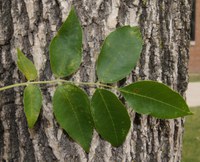Dakota Gardener: Still on the Lookout for Emerald Ash Borer
(Click an image below to view a high-resolution image that can be downloaded)
By Joe Zeleznik, Forester
NDSU Extension
Every year, just before Memorial Day, I work with colleagues at the North Dakota Forest Service (NDFS) and North Dakota Department of Agriculture (NDDA) to do an informational campaign during “Emerald Ash Borer Awareness Week.”
Emerald ash borer (EAB) is an insect from Asia that attacks and kills ash trees, such as our native green ash and black ash.
We don’t exactly “celebrate” the week, but instead we use it as an opportunity to remind people about the importance of tree species diversity and the role of firewood in the spread of this harmful insect.
As a scientist, though, I’d like to start with some data:
- 35 – Number of states in which EAB has been found. Fortunately, North Dakota still isn’t one of them, but the insect has been found in the Sioux Falls area of South Dakota, Sauk Centre, Minn., and even in Winnipeg, Manitoba.
- 5 mile per year – The average spread of EAB, just by flying
- 55+ mph – The rate of spread of EAB when moving within infested firewood
- 55 – Average number of eggs laid by a female EAB
- 150 – Maximum number of eggs laid by a female EAB
- 30% – Proportion of North Dakota conservation plantings consisting of green ash
- 60% – Proportion of North Dakota native forests consisting of green ash
- 65%+ – Amount of green ash in many communities in North Dakota
- 250 – Estimated number of EAB traps to be distributed this summer by the NDDA
- 0 – Number of EAB found in North Dakota so far
Every year, my colleagues and I inspect dozens of ash trees around the state to see if they’re infested with EAB. So far, we’ve found no EAB, and we’re hoping the same holds true for 2021. But the insect gets closer every year, and that’s worrisome, given the large percent of ash trees in our forests.
Fortunately, we have several things we can do to minimize the risk of EAB. First, when using firewood, “Buy it where you burn it.” When you go camping, get your firewood at your destination; don’t bring it with you. Moving infested firewood is one of the main methods of EAB spread. Most campgrounds have firewood for sale on-site or they list nearby vendors.
Second, we can treat our forests like the long-term investment that they are. As my financial adviser likes to say: Diversify! Diversify! Diversify! Check out the North Dakota Tree Selector (https://www.ag.ndsu.edu/tree-selector) for a listing of a number of tree (and shrub) species that are broadly adapted across North Dakota.
Finally, if you think your ash trees might be infested with EAB, please don’t hesitate to contact your county Extension agent, the NDFS or the NDDA to arrange for a site visit. If this destructive insect is in North Dakota, we want to find it sooner rather than later.
I’m grateful that EAB hasn’t been found here yet. Every year that we delay gives us more time to plant new/different tree species. What will you plant this year?
For more information about gardening, contact your local NDSU Extension agent. Find the Extension office for your county at https://www.ag.ndsu.edu/extension/directory/counties.
NDSU Agriculture Communication - May 4, 2021
Source: Joe Zeleznik, 701-231-8143, joseph.zeleznik@ndsu.edu
Editor: Ellen Crawford, 701-231-5391, ellen.crawford@ndsu.edu




